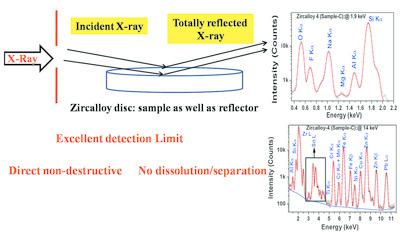当前位置:
X-MOL 学术
›
J. Synchrotron Radiat.
›
论文详情
Our official English website, www.x-mol.net, welcomes your
feedback! (Note: you will need to create a separate account there.)
Direct non-destructive total reflection X-ray fluorescence elemental determinations in zirconium alloy samples.
Journal of Synchrotron Radiation ( IF 2.4 ) Pub Date : 2020-08-19 , DOI: 10.1107/s1600577520009364 Kaushik Sanyal 1 , Buddhadev Kanrar 1 , Sangita Dhara 1 , Mirta Sibilia 2 , Arijit Sengupta 3 , Andreas Germanos Karydas 4 , Nand Lal Mishra 1
Journal of Synchrotron Radiation ( IF 2.4 ) Pub Date : 2020-08-19 , DOI: 10.1107/s1600577520009364 Kaushik Sanyal 1 , Buddhadev Kanrar 1 , Sangita Dhara 1 , Mirta Sibilia 2 , Arijit Sengupta 3 , Andreas Germanos Karydas 4 , Nand Lal Mishra 1
Affiliation

|
The development of a direct non‐destructive synchrotron‐radiation‐based total reflection X‐ray fluorescence (TXRF) analytical methodology for elemental determinations in zirconium alloy samples is reported for the first time. Discs, of diameter 30 mm and about 1.6 mm thickness, of the zirconium alloys Zr‐2.5%Nb and Zircalloy‐4 were cut from plates of these alloys and mirror polished. These specimens were presented for TXRF measurements directly after polishing and cleaning. The TXRF measurements were made at the XRF beamline at Elettra synchrotron light source, Trieste, Italy, at two different excitation energies, 1.9 keV and 14 keV, for the determinations of low‐ and high‐Z elements, respectively. The developed analytical methodology involves two complementary quantification schemes, i.e. using either the fundamental parameter method or relative sensitivity based method, allowing quantification of fifteen minor and trace elements with respect to Zr with very good precision and accuracy. In order to countercheck the TXRF analytical results, some samples were analyzed using the DC arc carrier distillation atomic emission spectrometry technique also, which shows an excellent agreement with the results of the TXRF‐based methodology developed in this work. The present work resulted in a non‐destructive TXRF elemental characterization methodology of metal and alloy samples avoiding the cumbersome dissolution and matrix separation which are normally required in other techniques and traditional methods of TXRF determination. In addition, the production of analytical waste could also be avoided to a large extent. Although the work was carried out for specific applications in the nuclear industry, it is equally suitable for other such samples in different industrial applications.
中文翻译:

锆合金样品中直接无损全反射X射线荧光元素测定。
首次报道了开发直接基于无损同步辐射的全反射X射线荧光(TXRF)分析方法来测定锆合金样品中元素的方法。从这些合金板上切下直径为30 mm,厚度约为1.6 mm的锆合金Zr-2.5%Nb和Zircalloy-4圆盘,并进行镜面抛光。这些样品在抛光和清洁后直接用于TXRF测量。TXRF测量是在意大利的里雅斯特Elettra同步加速器光源的XRF光束线上以两种不同的激发能1.9 keV和14 keV进行的,分别用于确定低Z和高Z元素。发达的分析方法涉及两个互补的量化方案,即使用基本参数方法或基于相对灵敏度的方法,可以以非常好的精度和准确度对Zr定量15个微量和痕量元素。为了抵消TXRF的分析结果,还使用直流电弧载流蒸馏原子发射光谱技术对一些样品进行了分析,这与本工作中开发的基于TXRF的方法学的结果显示出极好的一致性。目前的工作导致了金属和合金样品的无损TXRF元素表征方法,避免了其他技术和传统TXRF测定方法通常需要的繁琐的溶解和基质分离。此外,还可以在很大程度上避免产生分析废料。
更新日期:2020-08-19
中文翻译:

锆合金样品中直接无损全反射X射线荧光元素测定。
首次报道了开发直接基于无损同步辐射的全反射X射线荧光(TXRF)分析方法来测定锆合金样品中元素的方法。从这些合金板上切下直径为30 mm,厚度约为1.6 mm的锆合金Zr-2.5%Nb和Zircalloy-4圆盘,并进行镜面抛光。这些样品在抛光和清洁后直接用于TXRF测量。TXRF测量是在意大利的里雅斯特Elettra同步加速器光源的XRF光束线上以两种不同的激发能1.9 keV和14 keV进行的,分别用于确定低Z和高Z元素。发达的分析方法涉及两个互补的量化方案,即使用基本参数方法或基于相对灵敏度的方法,可以以非常好的精度和准确度对Zr定量15个微量和痕量元素。为了抵消TXRF的分析结果,还使用直流电弧载流蒸馏原子发射光谱技术对一些样品进行了分析,这与本工作中开发的基于TXRF的方法学的结果显示出极好的一致性。目前的工作导致了金属和合金样品的无损TXRF元素表征方法,避免了其他技术和传统TXRF测定方法通常需要的繁琐的溶解和基质分离。此外,还可以在很大程度上避免产生分析废料。











































 京公网安备 11010802027423号
京公网安备 11010802027423号